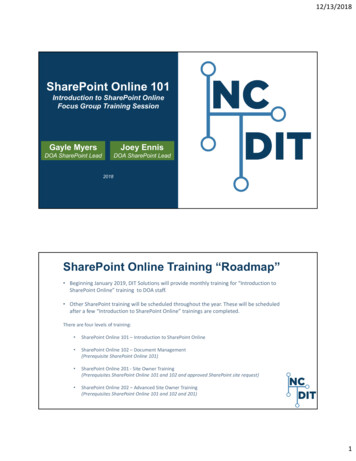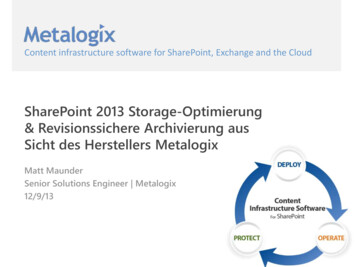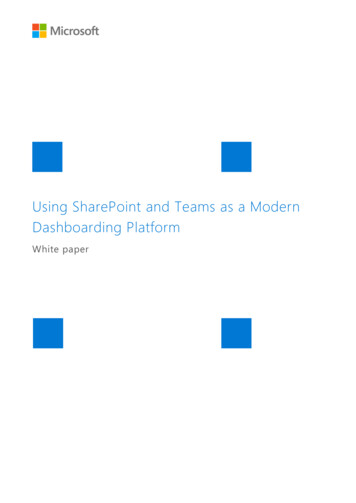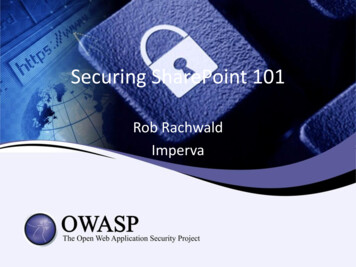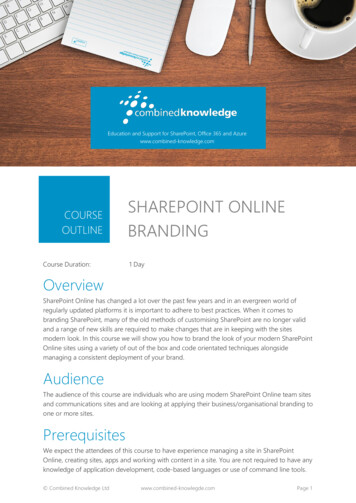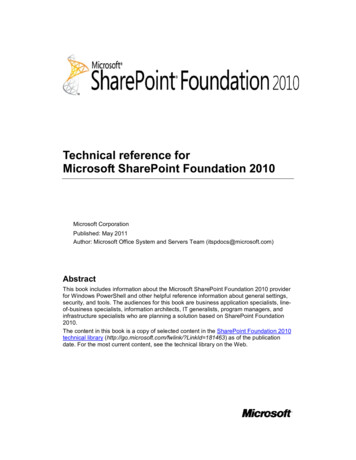
Transcription
Technical reference forMicrosoft SharePoint Foundation 2010Microsoft CorporationPublished: May 2011Author: Microsoft Office System and Servers Team (itspdocs@microsoft.com)AbstractThis book includes information about the Microsoft SharePoint Foundation 2010 providerfor Windows PowerShell and other helpful reference information about general settings,security, and tools. The audiences for this book are business application specialists, lineof-business specialists, information architects, IT generalists, program managers, andinfrastructure specialists who are planning a solution based on SharePoint Foundation2010.The content in this book is a copy of selected content in the SharePoint Foundation 2010technical library (http://go.microsoft.com/fwlink/?LinkId 181463) as of the publicationdate. For the most current content, see the technical library on the Web.
This document is provided “as-is”. Information and views expressed in this document,including URL and other Internet Web site references, may change without notice. Youbear the risk of using it.Some examples depicted herein are provided for illustration only and are fictitious. Noreal association or connection is intended or should be inferred.This document does not provide you with any legal rights to any intellectual property inany Microsoft product. You may copy and use this document for your internal, referencepurposes. 2011 Microsoft Corporation. All rights reserved.Microsoft, Access, Active Directory, Backstage, Excel, Groove, Hotmail, InfoPath,Internet Explorer, Outlook, PerformancePoint, PowerPoint, SharePoint, Silverlight,Windows, Windows Live, Windows Mobile, Windows PowerShell, Windows Server, andWindows Vista are either registered trademarks or trademarks of Microsoft Corporation inthe United States and/or other countries.The information contained in this document represents the current view of MicrosoftCorporation on the issues discussed as of the date of publication. Because Microsoftmust respond to changing market conditions, it should not be interpreted to be acommitment on the part of Microsoft, and Microsoft cannot guarantee the accuracy of anyinformation presented after the date of publication.ii
ContentsGetting help . ixTechnical reference for SharePoint Foundation 2010. 1Other Resources . 1System Center Operations Manager knowledge articles (SharePoint Foundation2010) . 2ULS not enough storage for log directory - Event 2150 (SharePoint 2010 Products) . 5Event log flooding - Events 2158 2159 (SharePoint 2010 Products) . 7SQL Server database login failed - Event 3351 (SharePoint 2010 Products) . 8Backup failed due to insufficient permissions - Event 3353 (SharePoint 2010Products) . 10Other Resources . 11Cannot connect to SQL Server - Event 3355 (SharePoint 2010 Products) . 12The application pool account cannot add user accounts to Active Directory - Event3359 (SharePoint 2010 Products). 14Active Directory organization unit unregistered - Event 3360 (SharePoint 2010Products) . 16SQL Server database is full - Event 3758 (SharePoint 2010 Products). 17Database could not be accessed - Event 3760 (SharePoint 2010 Products) . 19Content deployment job failed - Events 4958 5323 5325 5335 (SharePoint 2010Products) . 22Content database is Read-Only - Event 4971 (SharePoint 2010 Products) . 24Insufficient SQL Server database permissions - Event 5214 (SharePoint 2010Products) . 26Unable to write to trace log - Event 5401 (SharePoint 2010 Products). 28Unknown SQL exceptions - Event 5586 (SharePoint 2010 Products) . 29SharePoint Foundation failed to create a site - Event 6141 (SharePoint 2010Products) . 33Unable to load authentication provider - Event 6143 (SharePoint 2010 Products). 34Insufficient permissions to write to the configuration data cache - Event 6395(SharePoint 2010 Products). 37iii
Alternate access mapping update failed - Event 6397 (SharePoint 2010 Products) . 38Service Instance timer execution failed - Event 6398 (SharePoint 2010 Products). 40ULS not enough free disk space - Event 6457 (SharePoint 2010 Products) . 44Access denied for writing to registry - Event 6588 (SharePoint 2010 Products) . 45Access denied for writing to disk - Event 6589 (SharePoint 2010 Products) . 47Application pool account must be registered as Kerberos - Event 6590 (SharePoint2010 Products) . 49SMTP service not running - Event 6599 (SharePoint 2010 Products) . 51Event handler failed to load - Event 6644 (SharePoint 2010 Products). 53Product Help Library Permission - Event 6769 (SharePoint 2010 Products). 54Cannot resolve name of the outbound SMTP server - Event 6856 (SharePoint 2010Products) . 55Cannot connect to SMTP host - Event 6857 (SharePoint 2010 Products) . 57Error occurred while communicating with SMTP server - Event 6858 (SharePoint2010 Products) . 59SharePoint lists cannot receive e-mail - Event 6872 (SharePoint 2010 Products) . 61E-mail service cannot deliver e-mail - Event 6873 (SharePoint 2010 Products) . 62Event receiver failed - Event 6875 (SharePoint 2010 Products). 63Backup timer job could not be created - Event 7035 (SharePoint 2010 Products). 64Central Administration update failed - Event 7037 (SharePoint 2010 Products) . 66Throttling starts alert- Events 8032 8062 (SharePoint 2010 Products). 68Cannot retrieve end point - Event 8070 (SharePoint 2010 Products) . 70Log folder does not exist - Event 8074 (SharePoint 2010 Products) . 71Usage timer job failed - Event 8075 (SharePoint 2010 Products). 72Business Data Connectivity Service - BDC database adapter connection exception Event 8080 (SharePoint 2010 Products) . 74Business Data Connectivity Service - BDC Web service proxy generations exception- Event 8082 (SharePoint 2010 Products) . 76Business Data Connectivity Service - BDC Proxy - unexpected exception - Event8085 (SharePoint 2010 Products). 78iv
Business Data Connectivity Service - SQL exception - Event 8086 (SharePoint 2010Products) . 80ULS trace log reaching maximum size - Event 8094 (SharePoint 2010 Products). 81ULS usage log reaching maximum size - Event 8095 (SharePoint 2010 Products) . 83STS signing certificate missing - Event 8303 (SharePoint 2010 Products) . 85STS cannot sign credentials - Event 8304 (SharePoint 2010 Products) . 86Claims cannot establish endpoint - Event 8305 (SharePoint 2010 Products) . 87STS claims provider error - Event 8307 (SharePoint 2010 Products). 88Administration service is not running (SharePoint 2010 Products) . 89Document conversion launcher unavailable (SharePoint 2010 Products). 90Document conversion load balancer unavailable (SharePoint 2010 Products) . 91Knowledge article is not yet available (SharePoint 2010 Products). 93Sandboxed code is running (SharePoint 2010 Products) . 95SharePoint Administration service is disabled (SharePoint 2010 Products). 96SharePoint Foundation 2010 search is not running (SharePoint 2010 Products) . 97SharePoint Health Analyzer has detected an error or warning (SharePoint 2010Products) . 98SharePoint Timer service could not start (SharePoint 2010 Products). 99SharePoint Timer service is not running (SharePoint 2010 Products). 100SQL Server remote access is disabled (SharePoint 2010 Products). 101Tracing service is not running (SharePoint 2010 Products) . 102Web application taking too long to render a page (SharePoint 2010 Products) . 103Web application unavailable (SharePoint 2010 Products) . 104Web site unavailable (SharePoint 2010 Products). 106SharePoint Health Analyzer rules reference (SharePoint Foundation 2010). 108Web Applications using Claims authentication require an update (SharePointFoundation 2010) . 111Automatic update setting inconsistent across farm servers (SharePoint Foundation2010) . 112v
Diagnostic logging is set to verbose (SharePoint Foundation 2010) . 113The server farm account should not be used for other services (SharePointFoundation 2010) . 114One or more services have started or stopped unexpectedly (SharePoint Foundation2010) . 115Databases used by SharePoint have fragmented indices (SharePoint Foundation2010) . 116Other Resources . 116Content databases contain orphaned items (SharePoint Foundation 2010) . 117Outbound e-mail has not been configured (SharePoint Foundation 2010). 118Some health analyzer rules do not have associated timer jobs (SharePointFoundation 2010) . 119Drives are running out of free space (SharePoint Foundation 2010). 120The paging file size should exceed the amount of physical RAM in the system(SharePoint Foundation 2010) . 121Built-in accounts are used as application pool or service identities (SharePointFoundation 2010) . 122Web Analytics: Monitors the health of the Report Consolidator component(SharePoint Foundation 2010) . 123Web Analytics: Verifies that when the Web Analytics is installed and running, usagelogging is enabled in the farm (SharePoint Foundation 2010). 124Web Analytics: Verifies that a web application is serviced by at most one WebAnalytics service application proxy (SharePoint Foundation 2010). 126Web Analytics: Verifies that the SQL Server Service Broker is enabled for the WebAnalytics staging databases (SharePoint Foundation 2010) . 127Installation reference (SharePoint Foundation 2010). 128Setup command-line reference (SharePoint Foundation 2010) . 129How to use a Setup command-line switch . 129Available switches and parameters. 129Run Setup with a Config.xml file at a command prompt . 132Psconfig command-line reference (SharePoint Foundation 2010) . 133How to use Psconfig commands . 133Available commands and parameters . 134Config.xml reference (SharePoint Foundation 2010) . 141Customizing Config.xml. 141vi
Config.xml element quick reference . 142How it works . 142Config.xml file format. 143Config.xml element reference . 144Windows PowerShell commands (SharePoint Foundation 2010). 155Installing SharePoint Products by using Windows PowerShell. 155Windows PowerShell installation cmdlets . 156Other Resources . 157Installation and other special directories (SharePoint Foundation 2010). 158Installation directory files . 158Web Part resource files . 178Web site content files . 178User permissions and permission levels (SharePoint Foundation 2010) . 180Default permission levels. 180User permissions. 181Other Resources . 186Database types and descriptions (SharePoint Foundation 2010). 187SharePoint Foundation 2010 databases . 188SQL Server system databases. 195User experience on read-only sites (SharePoint Foundation 2010) . 199Common tasks that are not available on a read-only site, and do not returnerrors . 199Common tasks that appear to be available in a read-only site, but returnerrors . 202Language packs (SharePoint Foundation 2010). 204Languages for word breakers and stemmers (SharePoint Foundation 2010) . 206Scripted deployment reference (SharePoint Foundation 2010) . 207Install-SharePoint . 207New-SharePointFarm . 208Join-SharePointFarm. 208Common site collection templates. 209Timer job reference (SharePoint Foundation 2010) . 212Manage timer jobs . 212Default timer jobs. 213SharePoint 2010 Administration Toolkit (SharePoint Foundation 2010). 220Installing the SharePoint 2010 Administration Toolkit (SharePoint Foundation 2010). 222Concepts. 223vii
Uninstalling the SharePoint 2010 Administration Toolkit (SharePoint Foundation2010) . 224Security Configuration Wizard manifest for SharePoint Foundation 2010 . 225Register the SCW manifest . 225Concepts. 226Load Testing Kit (SharePoint Foundation 2010) . 227Overview. 227Collect logs . 227Prepare data for analysis. 228Use the project file to generate a synthetic load . 230Conformance statement A-level (SharePoint Foundation 2010). 231Conformance statement for configuration and administration experience at Alevel . 231Conformance statement AA-level (SharePoint Foundation 2010) . 233Conformance statement for core reader, author, and contributor experienceat AA-level . 233Settings and features backed up from a farm configuration (SharePoint Foundation2010) . 235Settings and features backed up . 235Other Resources . ollection: Stsadm property(SharePoint Foundation 2010) . 238Parameters . 238Examples . 239viii
Getting helpEvery effort has been made to ensure the accuracy of this book. This content is alsoavailable online in the Office System TechNet Library, so if you run into problems you cancheck for updates at:http://technet.microsoft.com/officeIf you do not find your answer in our online content, you can send an e-mail message tothe Microsoft Office System and Servers content team at:itspdocs@microsoft.comIf your question is about Microsoft Office products, and not about the content of this book,please search the Microsoft Help and Support Center or the Microsoft Knowledge Baseat:http://support.microsoft.comix
Technical reference for SharePointFoundation 2010Published: May 12, 2010Technical reference includes information about Windows PowerShell for MicrosoftSharePoint Foundation 2010 and other useful reference information about generalsettings, security, and tools.In this section: Windows PowerShell for SharePoint Foundation 2010 (Available on TechNet f7-4690-95ba3a1651a92447(Office.14).aspx) System Center Operations Manager knowledge articles (SharePoint Foundation2010) User permissions and permission levels (SharePoint Foundation 2010) Database types and descriptions (SharePoint Foundation 2010) User experience on read-only sites (SharePoint Foundation 2010) Language packs (SharePoint Foundation 2010) SharePoint 2010 Administration Toolkit (SharePoint Foundation 2010) ection: Stsadm property(SharePoint Foundation 2010)Other ResourcesStsadm command-line tool (Windows SharePoint ry/cc288981(office.12).aspx)1
System Center Operations Managerknowledge articles (SharePointFoundation 2010)Published: May 12, 2010The articles in this section are knowledge articles for the Microsoft SharePointFoundation 2010 management pack for Microsoft System Center Operations Manager2007. Typically, you would see these articles after clicking a link in an alert in theOperations Manager console. You can use these articles to help you troubleshoot andresolve problems in SharePoint Foundation 2010.In this section: ULS not enough storage for log directory - Event 2150 (SharePoint 2010 Products) Event log flooding - Events 2158 2159 (SharePoint 2010 Products) SQL Server database login failed - Event 3351 (SharePoint 2010 Products) Backup failed due to insufficient permissions - Event 3353 (SharePoint 2010Products) Cannot connect to SQL Server - Event 3355 (SharePoint 2010 Products) The application pool account cannot add user accounts to Active Directory - Event3359 (SharePoint 2010 Products) Active Directory organization unit unregistered - Event 3360 (SharePoint 2010Products) SQL Server database is full - Event 3758 (SharePoint 2010 Products) Database could not be accessed - Event 3760 (SharePoint 2010 Products) Content deployment job failed - Events 4958 5323 5325 5335 (SharePoint 2010Products) Content database is Read-Only - Event 4971 (SharePoint 2010 Products) Insufficient SQL Server database permissions - Event 5214 (SharePoint 2010Products) Unable to write to trace log - Event 5401 (SharePoint 2010 Products) Unknown SQL exceptions - Event 5586 (SharePoint 2010 Products) SharePoint Foundation failed to create a site - Event 6141 (SharePoint 2010Products) Unable to load authentication provider - Event 6143 (SharePoint 2010 Products) Insufficient permissions to write to the configuration data cache - Event 6395(SharePoint 2010 Products) Alternate access mapping update failed - Event 6397 (SharePoint 2010 Products) Service Instance timer execution failed - Event 6398 (SharePoint 2010 Products)2
ULS not enough free disk space - Event 6457 (SharePoint 2010 Products) Access denied for writing to registry - Event 6588 (SharePoint 2010 Products) Access denied for writing to disk - Event 6589 (SharePoint 2010 Products) Application pool account must be registered as Kerberos - Event 6590 (SharePoint2010 Products) SMTP service not running - Event 6599 (SharePoint 2010 Products) Event handler failed to load - Event 6644 (SharePoint 2010 Products) Product Help Library Permission - Event 6769 (SharePoint 2010 Products) Cannot resolve name of the outbound SMTP server - Event 6856 (SharePoint 2010Products) Cannot connect to SMTP host - Event 6857 (SharePoint 2010 Products) Error occurred while communicating with SMTP server - Event 6858 (SharePoint2010 Products) SharePoint lists cannot receive e-mail - Event 6872 (SharePoint 2010 Products) E-mail service cannot deliver e-mail - Event 6873 (SharePoint 2010 Products) Event receiver failed - Event 6875 (SharePoint 2010 Products) Backup timer job could not be created - Event 7035 (SharePoint 2010 Products) Central Administration update failed - Event 7037 (SharePoint 2010 Products) Throttling starts alert- Events 8032 8062 (SharePoint 2010 Products) Cannot retrieve end point - Event 8070 (SharePoint 2010 Products) Log folder does not exist - Event 8074 (SharePoint 2010 Products) Usage timer job failed - Event 8075 (SharePoint 2010 Products) Business Data Connectivity Service - BDC database adapter connection exception Event 8080 (SharePoint 2010 Products) Business Data Connectivity Service - BDC Web service proxy generations exception- Event 8082 (SharePoint 2010 Products) Business Data Connectivity Service - BDC Proxy - unexpected exception - Event8085 (SharePoint 2010 Products) Business Data Connectivity Service - SQL exception - Event 8086 (SharePoint 2010Products) ULS trace log reaching maximum size - Event 8094 (SharePoint 2010 Products) ULS usage log reaching maximum size - Event 8095 (SharePoint 2010 Products) STS signing certificate missing - Event 8303 (SharePoint 2010 Products) STS cannot sign credentials - Event 8304 (SharePoint 2010 Products) Claims cannot establish endpoint - Event 8305 (SharePoint 2010 Products) STS claims provider error - Event 8307 (SharePoint 2010 Products) Administration service is not running (SharePoint 2010 Products) Document conversion launcher unavailable (SharePoint 2010 Products) Document conversion load balancer unavailable (SharePoint 2010 Products)3
Knowledge article is not yet available (SharePoint 2010 Products) Sandboxed code is running (SharePoint 2010 Products) SharePoint Administration service is disabled (SharePoint 2010 Products) SharePoint Foundation 2010 search is not running (SharePoint 2010 Products) SharePoint Health Analyzer has detected an error or warning (SharePoint 2010Products) SharePoint Timer service could not start (SharePoint 2010 Products) SharePoint Timer service is not running (SharePoint 2010 Products) SQL Server remote access is disabled (SharePoint 2010 Products) Tracing service is not running (SharePoint 2010 Products) Web application taking too long to render a page (SharePoint 2010 Products) Web application unavailable (SharePoint 2010 Products) Web site unavailable (SharePoint 2010 Products)4
ULS not enough storage for log directory- Event 2150 (SharePoint 2010 Products)Published: May 12, 2010Alert Name: ULS not enough storage for log directoryEvent ID: 2150Summary: The Microsoft SharePoint Foundation Tracing (SPTracev4) service is usedby Microsoft SharePoint Foundation 2010 to manage usage log output. When usagelogging is turned on, administrators can specify the path that is used to store the usagelogs. This log file is used by many applications that are built on top of SharePointFoundation 2010. This event occurs when not enough free space is available for logging.Symptoms: One or more of the following symptoms might appear: The usage log shows no new usage data. This event appears in the event log: Event ID: 2150 Description: Failed to create ausage log file at Log Location . There must be at least # of GBs needed to resumelogging GB of free space if the usage logs are on System Drive. Cause: The configured log location does not have enough free disk space for logging.Resolution: Free up disk space or relocate the usage log SharePoint Foundation 2010 could not write to the usage log. This usage logcontains information that is helpful for usage tracking and reporting.To free up disk space:1. Use Disk Cleanup to free up disk space where the usage log files are stored.2. Verify whether the trace log has enough disk space to run properly.3. If disk space is inadequate, try to clean the Temp folders on the drive.4. If this procedure does not solve the problem, you can relocate the usage log file to apartition that has more drive space.To relocate the log file:1. On the SharePoint Central Administration Web site, on the Quick Launch, clickMonitoring and in the Reporting section click Usage Logging.2. On the Usage Logging page, in the Logging Settings section, type the new locationfor the usage log file.3. Click OK.5
To check the usage log file:1. To verify that Microsoft SharePoint Foundation 2010 can create and write to theusage log file, on the Central Administration page click Monitoring, and in theReporting section click Usage Logging.2. On the Usage Logging page, in the Logging Settings section, copy the path of theusage log file.3. In Windows Explorer, navigate to the usage log file by using the copied path. Usagelog files are in binary format and the contents cannot be easily viewed andunderstood. The file size of the usage log increases over time and confirms thatusage logging is working.6
Event log flooding - Events 2158 2159(SharePoint 2010 Products)Published: May 12, 2010Alert Name: Event log floodingEvent ID: 2158 or 2159Summary: Event log flood protection prevents repeated events from being logged tothe Windows event log. When an event is logged several times in a short period, floodprotection prevents future
Microsoft SharePoint Foundation 2010 Microsoft Corporation Published: May 2011 Author: Microsoft Office System and Servers Team (itspdocs@microsoft.com) Abstract This book includes information about the Microsoft SharePoint Foundation 2010 provider for Windows PowerShell and other helpful reference information about general settings, security .

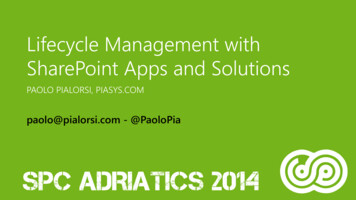
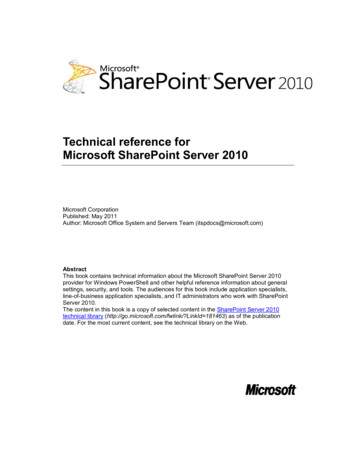
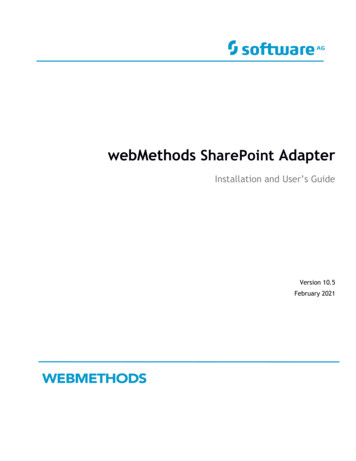
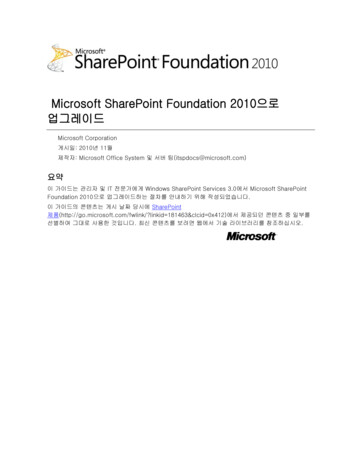
![Microsoft SharePoint Designer Crack [Mac/Win] (Final 2022)](/img/47/microsoft-sharepoint-designer.jpg)
